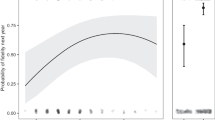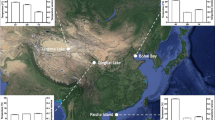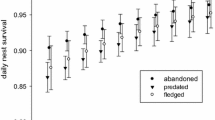Abstract
Variation in nest concealment is puzzling given the expected strong selection for safe nest sites. Selecting a concealed nest may decrease the risk of clutch predation but hinder parents from escaping predators, providing a possible solution to this paradox. Because the relative value of current versus future reproduction may vary with breeder age or state, nest concealment may also vary as a function of these attributes. We tested four predictions of the female and clutch safety trade-off hypothesis in eiders (Somateria mollissima): (1) nest concealment is negatively related to escape possibilities, (2) our capture rate of females is higher in covered nests, (3) egg predation is higher in open nests, and (4) overall nest success is unrelated to nest habitat. We also analysed nest microhabitat preferences and nest success relative to breeder age and body condition, controlling for nest spatial centrality. As expected, nest concealment and potential escape angle were negatively related, and capture by us, indicating female predation vulnerability, increased with nest cover. Clutch size was smaller in open nests, suggesting higher partial clutch predation, while it was larger among experienced and good-condition breeders. The probability of successful hatching was unrelated to nest habitat, positively associated with breeder experience, and negatively associated with hatching date. Experienced females selected more concealed and centrally located nests without sacrificing potential escape angles. The age-specific spatial distribution of nests on islands was unrelated to nest initiation dates, indicating no apparent competition. The age-specific preference of eiders for concealed nests may reflect declining reproductive value with age or confidence in surviving despite selecting a concealed nest. The apparently positive relationship between female age and survival and fecundity in eiders refutes the former alternative. Individual improvement in choosing safe nest sites, coupled with differential survival of individuals performing well, most likely explains age-specific nest-site preference and success.




Similar content being viewed by others
References
Albrecht T, Klvana P (2004) Nest crypsis, reproductive value of a clutch and escape decisions in incubating female mallards Anas platyrhynchos. Ethology 110:603–613. doi:10.1111/j.1439-0310.2004.00992.x
Amat JA, Masero JA (2004) Predation risk on incubating adults constrains the choice of thermally favourable nest sites in a plover. Anim Behav 67:293–300. doi:10.1016/j.anbehav.2003.06.014
Ardia DR (2005) Super size me: an experimental test of the factors affecting lipid content and the ability of residual body mass to predict lipid stores in nestling European starlings. Funct Ecol 19:414–420. doi:10.1111/j.1365-2435.2005.00997.x
Baillie SR, Milne H (1982) The influence of female age on breeding in the eider Somateria mollissima. Bird Study 29:55–66
Biro PA, Dingemanse NJ (2008) Sampling bias resulting from animal personality. Trends Ecol Evol 24:66–67. doi:10.1016/j.tree.2008.11.001
Blums P, Mednis A, Clark RG (1997) Effect of incubation body mass on reproductive success and survival of three European diving ducks: a test of the nutrient limitation hypothesis. Condor 99:916–925
Bolduc F, Guillemette M, Titman RD (2005) Nesting success of common eiders Somateria mollissima as influenced by nest-site and female characteristics in the Gulf of the St. Lawrence. Wildl Biol 11:273–279. doi:10.2981/0909-6396(2005)11[273:NSOCES]2.0.CO;2
Brown CR, Brown MB, Brazeal KR (2008) Familiarity with breeding habitat improves daily survival in colonial cliff swallows. Anim Behav 76:1201–1210. doi:10.1016/j.anbehav.2008.03.028
Burnham KP, Anderson DR (2002) Model selection and multimodel inference: a practical information-theoretic approach. Springer, New York
Bustnes JO, Erikstad KE (1993) Site fidelity in breeding common eider Somateria mollissima females. Ornis Fenn 70:11–16
Chalfoun AD, Martin TE (2007) Assessments of habitat preferences and quality depend on spatial scale and metrics of fitness. J Appl Ecol 44:983–992. doi:10.1111/j.1365-2664.2007.01352.x
Clark RG, Shutler D (1999) Avian habitat selection: pattern from process in nest-site use by ducks? Ecology 80:272–287. doi:10.2307/176996
Criscuolo F, Gabrielsen GW, Gendner JP, Le Maho Y (2002) Body mass regulation during incubation in female common eiders Somateria mollissima. J Avian Biol 33:83–88. doi:10.1034/j.1600-048X.2002.330113.x
D’Alba L, Monaghan P, Nager RG (2009) Thermal benefits of nest shelter for incubating female eiders. J Thermal Biol 34:93–99. doi:10.1016/j.jtherbio.2008.11.005
Danchin E, Giraldeau LA, Valone TJ, Wagner RH (2004) Public information: from nosy neighbors to cultural evolution. Science 305:487–491. doi:10.1126/science.1098254
Devries JH, Brook RW, Howerter DW, Anderson MG (2008) Effects of spring body condition and age on reproduction in mallards (Anas platyrhynchos). Auk 125:618–628. doi:10.1525/auk.2008.07055
Englund SR, O’Brien JJ, Clark DB (2000) Evaluation of digital and film hemispherical photography and spherical densiometry for measuring forest light environments. Can J For Res 30:1999–2005. doi:10.1139/cjfr-30-12-1999
Filliater TS, Breitwisch R, Nealen PM (1994) Predation on northern cardinal nests: does choice of nest site matter? Condor 96:761–768. doi:10.2307/1369479
Forslund P, Pärt T (1995) Age and reproduction in birds—hypotheses and tests. Trends Ecol Evol 10:374–378. doi:10.1016/S0169-5347(00)89141-7
Gerell R (1985) Habitat selection and nest predation in a common eider population in southern Sweden. Ornis Scand 16:129–139. doi:10.2307/3676478
Götmark F, Blomqvist D, Johansson OC, Bergkvist J (1995) Nest site selection: a trade-off between concealment and view of the surroundings? J Avian Biol 26:305–312. doi:10.2307/3677045
Jaenike JJ, Holt RD (1991) Genetic variation for habitat preference: evidence and explanations. Am Nat 137:S67–S90. doi:10.1086/285140
Kats RKH (2007) Common eiders Somateria mollissima in the Netherlands: the rise and fall of breeding and wintering populations in relation to stocks of shellfish. Alterra Sci Publ 19
Kilpi M, Lindström K (1997) Habitat-specific clutch size and cost of incubation in common eiders, Somateria mollissima. Oecologia 111:297–301. doi:10.1007/s004420050238
Kim S-Y, Monaghan P (2005) Interacting effects of nest shelter and breeder quality on behaviour and breeding performance of herring gulls. Anim Behav 69:301–306. doi:10.1016/j.anbehav.2004.06.002
Korschgen CE (1977) Breeding stress of female eiders in Maine. J Wildl Manage 41:360–373. doi:10.2307/3800505
Lokemoen JT, Duebbert HF, Sharp DE (1984) Nest spacing, habitat selection and behavior of waterfowl on Miller Lake Island, North Dakota. J Wildl Manage 48:309–332. doi:10.2307/3801163
Magnhagen C (1990) Reproduction under predation risk in the sand goby, Pomatoschistus minutus, and the black goby, Gobius niger: the effect of age and longevity. Behav Ecol Sociobiol 26:331–335. doi:10.1007/BF00171098
Martin TE (1998) Are microhabitat preferences of coexisting species under selection and adaptive? Ecology 79:656–670. doi:10.2307/176961
Martin TE, Scott J, Menge C (2000) Nest predation increases with parental activity: separating nest site and parental activity effects. Proc R Soc Lond B 267:2287–2293. doi:10.1098/rspb.2000.1281
McCleery RH, Perrins CM, Sheldon BC, Charmantier A (2008) Age-specific reproduction in a long-lived species: the combined effects of senescence and individual quality. Proc R Soc Lond B 275:963–970. doi:10.1098/rspb.2007.1418
McNamara JM, Houston AI (1996) State-dependent life histories. Nature 380:215–221. doi:10.1038/380215a0
Miller DA, Grand JB, Fondell TF, Anthony RM (2007) Optimizing nest survival and female survival: consequences of nest site selection for Canada geese. Condor 109:769–780. doi:10.1650/0010-5422(2007)109[769:ONSAFS]2.0.CO;2
Öst M, Vitikainen E, Waldeck P, Sundström L, Lindström K, Hollmén T, Franson JC, Kilpi M (2005) Eider females form non-kin brood-rearing coalitions. Mol Ecol 14:3903–3908. doi:10.1111/j.1365-294X.2005.02694.x
Öst M, Wickman M, Matulionis E, Steele B (2008a) Habitat-specific clutch size and cost of incubation in eiders reconsidered. Oecologia 158:205–216. doi:10.1007/s00442-008-1139-2
Öst M, Smith BD, Kilpi M (2008b) Social and maternal factors affecting duckling survival in eiders Somateria mollissima. J Anim Ecol 77:315–325. doi:10.1111/j.1365-2656.2007.01348.x
Pärt T (1995) Does breeding experience explain increased reproductive success with age? An experiment. Proc R Soc Lond B 360:113–117. doi:10.1098/rspb.1995.0067
Pinheiro JC, Bates DM (1999) Mixed-effects models in S and S-Plus, statistics and computing series. Springer, New York
Pöysä H (1999) Conspecific nest parasitism is associated with inequality in nest predation risk in the common goldeneye (Bucephala clangula). Behav Ecol 10:533–540. doi:10.1093/beheco/10.5.533
Pöysä H (2006) Public information and conspecific nest parasitism in goldeneyes: targeting safe nests by parasites. Behav Ecol 17:459–465. doi:10.1093/beheco/arj049
Pöysä H, Pesonen M (2007) Nest predation and the evolution of conspecific brood parasitism: from risk spreading to risk assessment. Am Nat 169:94–104. doi:10.1086/509943
Proaktor G, Milner-Gulland EJ, Coulson T (2007) Age-related shapes of the cost of reproduction in vertebrates. Biol Lett 3:674–677. doi:10.1098/rsbl.2007.0376
Ricklefs RE (1969) An analysis of nestling mortality in birds. Smithsonian Contrib Zool 9:1–48
Saether B-E (1990) Age-specific variation in reproductive performance in birds. Curr Ornithol 7:251–283
Schaffer WM (1974) Selection for optimal life histories: effects of age structure. Ecology 55:291–303. doi:10.2307/1935217
Schulte-Hostedde AI, Zinner B, Millar JS, Hickling GJ (2005) Restitution of mass-size residuals: validating body condition indices. Ecology 86:155–163. doi:10.1890/04-0232
Sergio F, Blas J, Baos R, Forero MG, Donázar JA, Hiraldo F (2009) Short- and long-term consequences of individual and territory quality in a long-lived bird. Oecologia 160:507–514. doi:10.1007/s00442-009-1314-0
Sinnott RW (1984) Virtues of the Haversine. Sky Telesc 68:159
Sokal RR, Rohlf FJ (1995) Biometry: the principles and practice of statistics in biological research. Freeman, New York
Spencer RJ (2002) Experimentally testing nest site selection: fitness trade-offs and predation risk in turtles. Ecology 83:2136–2144. doi:10.2307/3072045
Venables WN, Ripley BD (2002) Modern applied statistics with S, 4th edn. Springer, New York
Vergara P, Aguirre JI (2006) Age and breeding success related to nest position in a white stork Ciconia ciconia colony. Acta Oecol 30:414–418. doi:10.1016/j.actao.2006.05.008
Waldeck P, Kilpi M, Öst M, Andersson M (2004) Brood parasitism in a population of common eider (Somateria mollissima). Behaviour 141:725–739. doi:10.1163/1568539042245132
Wiebe KL, Martin K (1998) Costs and benefits of nest cover for ptarmigan: changes within and between years. Anim Behav 56:1137–1144. doi:10.1006/anbe.1998.0862
Williams GC (1966) Natural selection, the costs of reproduction and a refinement of Lack’s principle. Am Nat 100:687–690. doi:10.1086/282461
Yoccoz NG, Erikstad KE, Bustnes JO, Hanssen SA, Tveraa T (2002) Costs of reproduction in common eiders (Somateria mollissima): an assessment of relationships between reproductive effort and future survival and reproduction based on observational and experimental studies. J Appl Stat 29:57–64. doi:10.1080/02664760120108458
Acknowledgments
Mathieu Bélisle, Kim Jaatinen, Aleksi and Petteri Lehikoinen and Sarah Malick helped in the field. We thank Hanna Kokko for stimulating discussions about the life history view of nest-site selection, and Kim Jaatinen for statistical advice. Tvärminne Zoological Station provided facilities and lodging. Financial support was from the Academy of Finland (grants nos. 104582 and 128039 to M. Ö.), Oskar Öflunds stiftelse (to M. Ö.) and the Faculty Development and Research Fund of Colby-Sawyer College (to B. B. S.). All experiments comply with the current laws of Finland.
Author information
Authors and Affiliations
Corresponding author
Additional information
Communicated by Chris Whelan.
Rights and permissions
About this article
Cite this article
Öst, M., Steele, B.B. Age-specific nest-site preference and success in eiders. Oecologia 162, 59–69 (2010). https://doi.org/10.1007/s00442-009-1444-4
Received:
Accepted:
Published:
Issue Date:
DOI: https://doi.org/10.1007/s00442-009-1444-4




